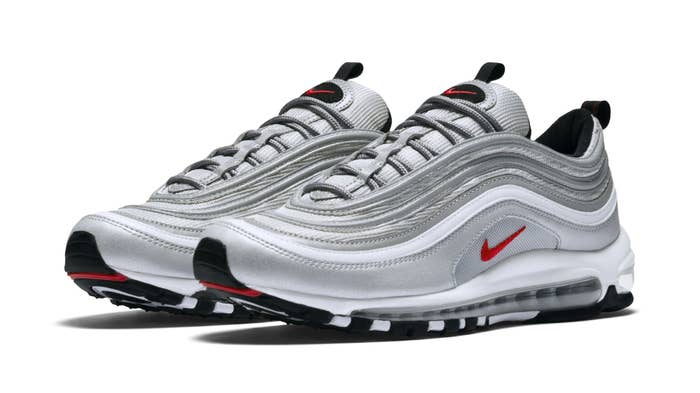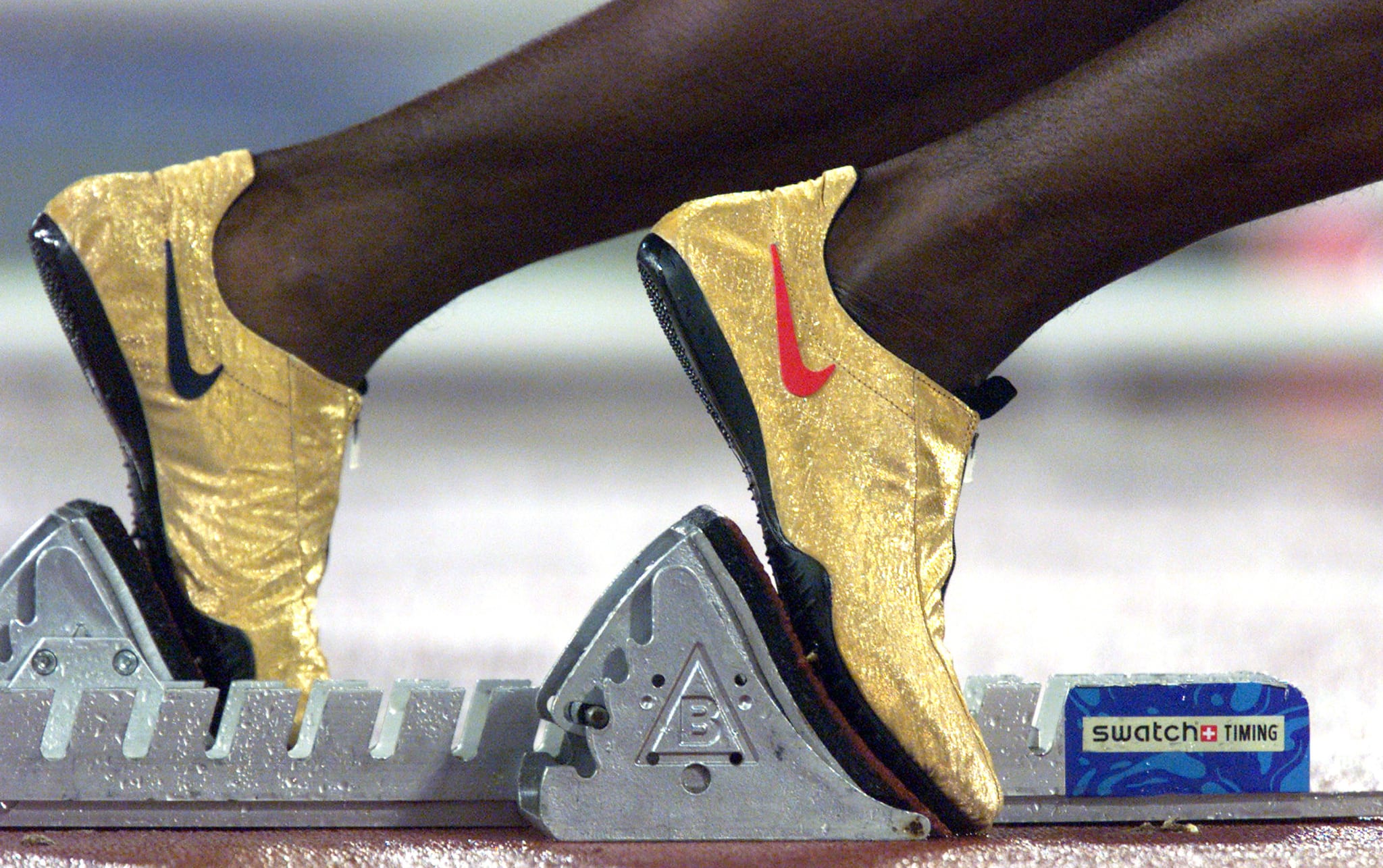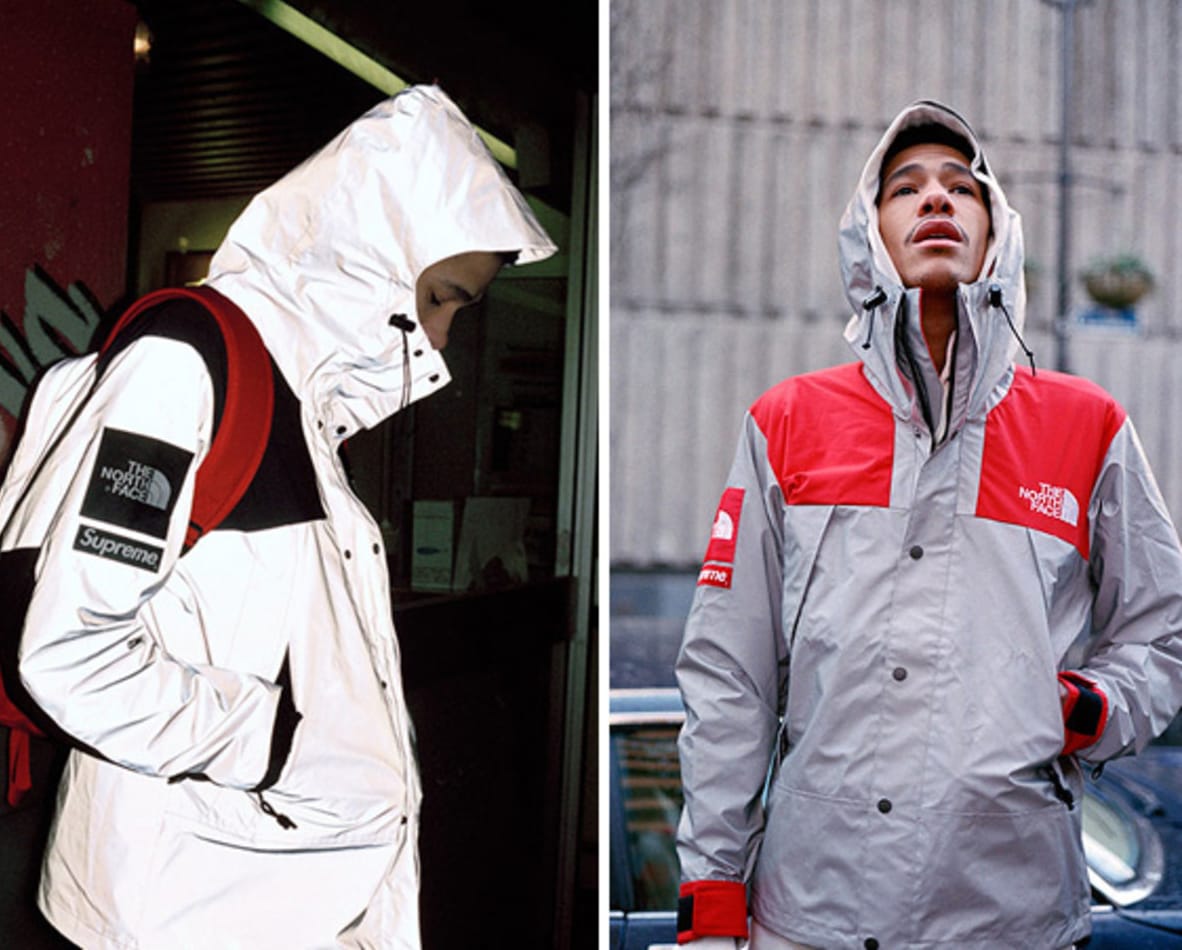
3M is everywhere, even if you don’t realize it. The company’s materials are on highways, street signs, and emergency vehicles. It makes Post-it Notes, painter’s tape, and air filters. It’s also responsible for some of our favorite sneakers like the Air Jordan 5, Nike Air Max 97, and many more.
The former Minnesota Mining and Manufacturing Company (renamed 3M in 2002) was founded in 1902 by five men: physician Dr. J. Danley Budd, railroad company executive Henry. S. Bryan, meat market owner Hermon W. Cable, attorney John Dwan, and William A. McGonagle, who worked at the Duluth and Iron Range Railroad with Bryan. As its original name suggests, the group planned for the Minnesota Mining and Manufacturing Company to specialize in mining corundum, an abrasive mineral used primarily for making things like sandpaper.
This idea fizzled out within a few years when they realized their Lake Superior, Minnesota, locale contained little to no corundum. A man named Lucius P. Ordway emerged as an investor in 1905, assuming the company’s debts, taking a majority share, and moving it to St. Paul. This led to rapid expansion and a focus on making items like abrasive cloth and masking tape. In 1937, vice president Richard P. Carlton started a laboratory to create reflective material for highways, which led to 3M’s first major breakthrough the following year and would later end up changing the way we see footwear.
The year was 1938 when University of Minnesota engineering graduate Harry Heltzer was tasked by Carlton to find a way to make highway stripes more visible than the plain white or yellow paints used at the time. Heltzer, who started as a $12-per-week employee, began looking for ways to incorporate reflective glass beads, using science experiments to dial in the technology.
“My first ones involved melting glass in a crucible about the size of a cup and pouring it out of the sixth floor of the Benz Building,” Heltzer said. “When you melt glass and pour it in a thin stream, it breaks into particles that turn into bubbles. I’d run down the six floors and sweep up what I had.”
Heltzer’s experiments led to the development of Scotchlite, one of 3M’s most well-known products and the one that is most commonly used in footwear. Readers likely recognize its use on the aforementioned Air Jordan 5’s tongue, the Nike Air Max 97’s overlays, or apparel like Supreme’s Spring/Summer 2013 The North Face collab. Scotchlite has been technologically improved over the years to make it more applicable to different surfaces, durable, and weather resistant, but the heart of the high-visibility retroreflective material remains the same. Meanwhile, Heltzer’s revolutionary invention was the start of his ascension within the company, where he would became CEO in 1970 before resigning five years later over illegal contributions to Richard Nixon’s 1972 presidential campaign.
To find out more about Scotchlite material, 3M’s connection to sneakers, and the brand’s recent collaborations, we caught up with Brian Rice, chief brand and design officer, and Ryan Gallagher, global marketing manager for Scotchlite reflective material. This interview with them has been edited and condensed for clarity.
For a lot of sneaker enthusiasts, 3M started popping up in the early ’90s with the Air Jordan 5 and on running shoes from that era. What can you tell me about that period?
Gallagher: The Air Jordan 5 is one of the hallmark collaborations that we’ve had with Nike. That was obviously long ago, prior to my tenure at 3M, but it still remains one of the most notable Air Jordans, as well as one of the most notable that our material has been on. And where we really start to see things pick up between us and Nike are right around in the mid-’90s. They took the lead in putting reflective material on running shoes, alongside brands like Adidas. That’s where we really started to collaborate across a broader range of footwear. Our products showed up on the Air Max 95, Air Max 97. So, if you remember those long-sweeping, sinuous stripes of reflective on the Air Max 97. That really, again, was another fuel for us to continue to work deeper and deeper together.

What about these days? How is it used on modern shoes?
Gallagher: Most footwear brands and designers fall into two camps, where they’re looking to utilize our materials for the protective and visibility value that it offers, as well as looking for more of a visual impact. Something that could be considered a bit more decorative. Our material serves both of those purposes quite well. Obviously, it’s a cool technology that can create a really impactful look, whether it’s at a retail store or an Instagram post. And that’s where a lot of our brand partners are looking, is to be able to create something that is functional. Because everything should be intentional in well-designed footwear, but also it can be impactful through the various means in which they deliver or connect with their customers.
So working with numerous brands, it really spans quite a large gamut in terms of how these designers and developers approach using reflective material. From Nike’s perspective, their intent the entire time [with the new 3M collaboration] was to develop a story around “protect for their 2020 holiday offering. When we’re working with our customers, we’re most often immediately aligned on focusing on problem-solving to improve people’s lives. This is by no accident. We work very hard at that. With Nike, through our 3M focus on solving toward human-centered values, like protection, warmth, and visibility, there was immediately a shared goal for both organizations.
We have other brands that are looking to develop their own visibility standards. So, certain brands want to look into identifying, “How can we work with 3M? How can we better understand how much material is the right amount to put on our shoes? And what is the proper placement, and how can we evaluate that?”
So, what we do with those brands is we say: “Hey, you’ve come to the right place. We are the leaders in this area. We have vision scientists on our staff. We have people who help write regulatory standards. And we also have a three-mile test track where you can go and test your designs out, and work with us to ensure that we’re evaluating in a proper setting, and helping you improve your designs.”
So the brands can actually come up with a sample or a prototype, and test it out there at your facility to make sure that the Scotchlite or other materials function the way they intended?
Gallagher: Absolutely. So, it’s a fascinating track. It’s used across different businesses and divisions inside of 3M to help test everything from traffic safety solutions, to Scotchlite, to whatever else they end up testing out there.
We package this as an education platform. We go out there at dusk, we teach them about dusk and dawn visibility, and how the environment, and the life, and the objects, and the infrastructure around us affect how we see as humans. It’s extremely enlightening and informative to have people be able to learn about exactly what is happening from a vision science, from a psychological perspective, from a physiological perspective, and also from an environmental perspective. Those are the three key things that help formulate visibility or more accurately conspicuity.
We work to ensure that our users are conspicuous, not just visible. So, if you can see something, that’s great, but can you pick it out in a crowd? Can you ensure that that is a human? Because we know from studies that humans or drivers, let’s just call them drivers because they’re the ones who present the most danger to consumers, drivers are able to react quicker when they understand and identify something as human versus as a non-human object. We’re just hardwired to be able to understand exactly the movements and the motions of humans. It’s in our biology from Day 1. And there’s numerous studies and really cool tools that help to show that.
After we run the dusk demo, we then take them out onto a completely pitch black track, drive them around the track, and set up different environmental scenes that we believe would be most appropriate for their use scenarios. Then, we take our experts, we take their designers and the developers, and we look at it in real time, discuss, refine, and help them come towards the decisions to make a better, more effective product.
Can you break down how Scotchlite works?
Gallagher: Basically, so let’s call it four major components to our technology. The top is millions of microscopic glass beads. That is the layer that you can run your hand across, and close to the surface of the material. Those glass beads redirect the light towards the back and the center of that glass bead. At the back of the center of that glass bead, that is where we’ve deposited our vapor-coated mirror. What that does then is that it helps bounce the light back through the glass beads, back to where the light had come from.
The third part to it then is our binder layer. That’s what holds everything together. That’s then followed by either an adhesive, like a heat-activated adhesive that’s going to help bond our material to the shoe or the piece of apparel, or you could replace that adhesive out with a fabric, and sew on our material.
But the main two drivers of retroreflective material are those glass beads and the mirror. The main driver or the main concept around retroreflective is that it reflects back to its light source. If you think about it, there are many different ways things can reflect. A mirror or say, a disco ball, you can have scatter reflective. Ours collects the light, and then returns it directly back to the source. That’s why you see things that light up so well from a car, or if you hold your iPhone light up to your eyes and view reflective from that standpoint, or a flash on a camera. That’s why it becomes so powerful, that it’s taking that light and sending it right back to the source.
That’s where that technology has always outperformed technologies like LED lighting. Or things of that nature, where people are trying to incorporate electronics into it. Because that little LED pipe on your running vest is never going to be more powerful than a car’s headlights. But unfortunately, a car’s headlights aren’t enough to help drivers see a human. Because it’s just there’s, again, physiological, psychological, and environmental things that play there. So, we do need that extra help as runners, as cyclists, from the retroreflective material to amplify, and send that light back to the driver.
Is there anything over the years, anything that stands out as just major achievements whether technology-wise, or just some of your favorites?
Gallagher: Being present on the Air Jordan is something that we’re still very proud of, and we still are in connection with the Air Jordan brand.
I think one of my favorites is Michael Johnson’s gold reflective shoes for the 2000 Olympics. For the 1996 Olympics, Michael Johnson had worn some gold, I think maybe some sort of shimmering, for lack of a better term, shoes for the ‘96 Olympics. He really wanted, in prep for the 2000 Olympics, Nike came to us and asked for a really bold material. Reflective was immediately what came to mind, and they wanted to use real gold. That was a challenge for us because typically our product has a silver look to it. So, when they came to us asking for gold, we actually were working with Tobie Hatfield at the time, we would be sending samples back and forth for evaluation at Nike. Real 24-karat gold, not the appearance of it, and it had to be highly reflective. Our scientists from our corporate labs, not just our Scotchlite scientists, but this was a very, I’ll say, an initiative that spanned many different labs across the company. to help design a reflective material in a way that could utilize this vapor-coated 24-karat gold.
Not an easy thing for us to do, and certainly not cheap, but we were able to achieve it. We developed a completely unique means for processing and creating the material. I’m not a scientist, but it’s a fascinating project that came to light where we then ended up producing I believe about 40 pairs. We had to produce that many because Michael Johnson never liked to wear a pair of shoes twice, and he would often throw them into the crowd. So, if you were there at the 2000 Olympics and got one of those, you got real 24-karat gold made by 3M Scotchlite.

You mentioned that gold wasn’t a color that is usually associated with Scotchlite, and it’s traditionally silver, but it seems like nowadays a lot of colors are in your arsenal. Is that accurate, or is silver still the main one?
Gallagher: Silver historically has always been one of the most popular, and still the most heavily used. But we, yes, well, over a decade ago, we started exploring different colors of the material, whether it’s 3M producing that exclusively, or having our converting partners help to create custom colorized materials.
Nike was actually one of the first brands to onboard our colorized material that was offered through one of our converters. I’ll pause just for a moment, because I keep on bringing up converters. What we do is we create the master role, but we rely on converters, which are our channel partners who take our material, and they’re the ones who could be laser cutting or dye cutting it into that logo that is on your shoe or your apparel. Or they’re the ones who are adding a color to it, or adding another backing to it that might be optimized for the type of product that it goes onto. That’s the value that our converters bring. They can really optimize, customize for every little project. Whereas as 3M, we rely on them to do that, and we primarily focus on the broader science and technology of it.
One of our most recent innovations is our C790 carbon black material. That’s a material that we developed in-house to come out as inherently black. So we don’t need work with our converting partners. You don’t need to add any extra processes. We’ve turned silver into black at our manufacturing facilities, and that is the deepest black visual with the highest retroreflectivity that we’ve seen on the market. Typically those two attributes are in tension with one another.
Previously to developing that product, we had designers saying, “We want something black,” but then they would have to give up the retroreflective brightness. So, they would say, “OK. Well, we want something bright,” then they would have to have a less deep black color.
So what we were able to do is eliminate that compromise, and create something that can give them both brightness and deep color. We also added in a high stretch component to it to arm our customers with a much more powerful tool to help envision their design.
How about 3M’s work with Supreme?
Gallagher: Supreme has been a loyal customer of 3M Scotchlite reflective material. When they created the jacket, they had that Supreme and The North Face jacket collaboration several years ago, that was one that was super notable. We’ve been working with Supreme in various means. Most recently they created a collection using our reflective yarn where they’re weaving in the Supreme name and reflective yarn inside of the jacket, or the pants and the hat material. So, you can see this glowing, repeating “Supreme” pattern on that collection, which was released in 2019.

Your recent work with Nike (Holiday 2020) and Adidas (Nite Jogger collection, July 2019) featured more 3M branding than usual, whether it be the hang tags or the large, printed logos. Was there a reason behind that?
Rice: A lot of the conversations that we had with Nike about the role of the co-branding, if you will. Getting the right balance of ensuring that consumers and customers still know that it’s Nike, but they also know that there are materials and science inside it that is brought to you by the makers of 3M. It was a lot of conversations about how do we use the logo? Where do we place it? A lot of conversations, as you can imagine, with our legal partners. To make sure a lot of that satisfies both organizations. I also believe that’s kind of what’s the magic of having two design organizations kind of work together, but also kind of helping their legal entities resolve those types of things. I think we came up with a very nice balance of both, to ensure that it’s a win-win for both Nike customers and consumers, and also for 3M.
I hope [we continue to use more branding], because I think this is very much aligned with what we do as an organization and as a company. Just as our text says: 3M science. Applied to life. And this is just one of those lives that our science is playing an important role in. It just happens to be, and call it the streetwear, lifestyle, kind of footwear industry where I think again, many consumers may not have known or thought about us in that way. I think it allows us to reach new audiences and channels, help people understand the kind of value that we create for society, but done in a way that’s cool and that’s relevant.
